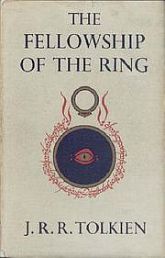Ideally one should write about the three books of The Lord of the Rings as a unit, since that’s the way J.R.R. Tolkien wrote them. It was the publisher’s decision to split the novel into three parts, a decision that the author only grudgingly accepted. He wanted LOTR published in six parts, with book 1 called The Return of the Shadow, and book 2 called The Fellowship of the Ring.
 But more importantly, in an ideal world one would be able to discuss The Fellowship of the Ring without being overshadowed by Peter Jackson’s film of the same name. Unfortunately, for me that’s impossible. I’ve seen the films probably a dozen times each since their release, enough that I can recite most of the dialogue word for word. The Extended Edition of Fellowship is one of my favorite films ever, ever, ever.
But more importantly, in an ideal world one would be able to discuss The Fellowship of the Ring without being overshadowed by Peter Jackson’s film of the same name. Unfortunately, for me that’s impossible. I’ve seen the films probably a dozen times each since their release, enough that I can recite most of the dialogue word for word. The Extended Edition of Fellowship is one of my favorite films ever, ever, ever.
But this is the first time I’ve re-read Tolkien since the film’s release, so I was constantly reacting to things that were different from what I’m used to — as if the books were the adaptation of the films and not the other way around. And in case that’s not irritating enough, I couldn’t picture anyone but Viggo Mortensen and Elijah Wood as Aragorn and Frodo, while Ian McKellen’s voice kept ringing out whenever Gandalf opened his mouth. It’s kind of like reading those annoying New Testament Bibles where Jesus’s words are printed in red; every snippet of dialogue that was used in the films stands out.
It’s especially a nuisance when you consider that J.R.R. Tolkien and Peter Jackson had vastly different agendas. Jackson made wonderful films in their own right. But they’re distinctly different in tone from the books, and I’m convinced now that Tolkien himself would have hated them.
What’s the difference? Take just one example, the battle with the orcs and the cave troll in the mines of Moria. Jackson lavishes plenty of attention on the battle, with multiple decapitations, thrown swords, close escapes, and a (somewhat clunky) CGI troll that vexes the Fellowship for a good ten minutes. But in the book, here’s how Tolkien describes that battle:
The affray was sharp, but the orcs were dismayed by the fierceness of the defence. Legolas shot two through the throat. Gimli hewed the legs from under another that had sprung up on Balin’s tomb. Boromir and Aragorn slew many. When thirteen had fallen the rest fled shrieking, leaving the defenders unharmed, except for Sam who had a scratch along the scalp.
There are a few more paragraphs describing the setup and denouement, but you can tell that Tolkien’s heart isn’t in it. The entirety of the scene that Jackson spends fifteen minutes on is a single page of Tolkien’s manuscript.
In fact, I was stunned to discover that all of the action sequences that thrilled me as a kid are really much, much shorter than I had remembered. The flight to the Ford? A measly 2 1/2 pages. Gandalf’s confrontation with the Balrog? 2 1/2 pages. Frodo’s fight with the Nazgûl near Weathertop? One page. And just think of all the dramatic sequences that Tolkien either doesn’t describe at all or relegates to a character’s secondhand report:
- Gandalf’s confrontation with Saruman and escape from Orthanc
- Gandalf’s battle with the Black Riders on Weathertop
- Gollum’s escape from Mirkwood
- The Black Riders’ incursion into Bree
- The elves’ battle with the orcs inside Lothlórien
- Boromir’s last battle with the orcs
- Glorfindel’s attack on the Nazgûl at the Ford
And that’s all just in Fellowship. The issue will become even more pronounced in The Two Towers, when Tolkien chooses to sit out the ents’ attack on Isengard.
 If you’re going to read the complete works of Tolkien properly, you definitely should not follow The Silmarillion with The Hobbit. (
If you’re going to read the complete works of Tolkien properly, you definitely should not follow The Silmarillion with The Hobbit. ( Gormenghast is a suitable companion-piece to Titus Groan. The two are so alike in tone and theme, that they seem to have been written in a single burst of inspiration. Peake provides us with an extended cast of characters, this time including Headmaster Bellgrove and his professors; he follows the rise of Steerpike’s crooked ambitions to their ruinous end; and he gives us a climactic manhunt that’s every bit as insanely drawn out as the battle between Flay and Swelter from the first novel.
Gormenghast is a suitable companion-piece to Titus Groan. The two are so alike in tone and theme, that they seem to have been written in a single burst of inspiration. Peake provides us with an extended cast of characters, this time including Headmaster Bellgrove and his professors; he follows the rise of Steerpike’s crooked ambitions to their ruinous end; and he gives us a climactic manhunt that’s every bit as insanely drawn out as the battle between Flay and Swelter from the first novel.